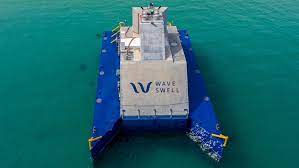
Breaking News
 Trump casually confirms first land strike on plant in Venezuela: 'We knocked that out'
Trump casually confirms first land strike on plant in Venezuela: 'We knocked that out'
 The End Game Has Begun For Our Current Financial System
The End Game Has Begun For Our Current Financial System
 Silver, Supply Chains, and the Reassertion of the Monroe Doctrine
Silver, Supply Chains, and the Reassertion of the Monroe Doctrine
 Ilhan Omar's Husband's Venture Capital Firm Removes Names From Website Under Scrutiny
Ilhan Omar's Husband's Venture Capital Firm Removes Names From Website Under Scrutiny
Top Tech News
 EngineAI T800: Born to Disrupt! #EngineAI #robotics #newtechnology #newproduct
EngineAI T800: Born to Disrupt! #EngineAI #robotics #newtechnology #newproduct
 This Silicon Anode Breakthrough Could Mark A Turning Point For EV Batteries [Update]
This Silicon Anode Breakthrough Could Mark A Turning Point For EV Batteries [Update]
 Travel gadget promises to dry and iron your clothes – totally hands-free
Travel gadget promises to dry and iron your clothes – totally hands-free
 Perfect Aircrete, Kitchen Ingredients.
Perfect Aircrete, Kitchen Ingredients.
 Futuristic pixel-raising display lets you feel what's onscreen
Futuristic pixel-raising display lets you feel what's onscreen
 Cutting-Edge Facility Generates Pure Water and Hydrogen Fuel from Seawater for Mere Pennies
Cutting-Edge Facility Generates Pure Water and Hydrogen Fuel from Seawater for Mere Pennies
 This tiny dev board is packed with features for ambitious makers
This tiny dev board is packed with features for ambitious makers
 Scientists Discover Gel to Regrow Tooth Enamel
Scientists Discover Gel to Regrow Tooth Enamel
 Vitamin C and Dandelion Root Killing Cancer Cells -- as Former CDC Director Calls for COVID-19...
Vitamin C and Dandelion Root Killing Cancer Cells -- as Former CDC Director Calls for COVID-19...
 Galactic Brain: US firm plans space-based data centers, power grid to challenge China
Galactic Brain: US firm plans space-based data centers, power grid to challenge China
Blowhole wave energy generator exceeds expectations in 12-month test

As we've discussed before, the UniWave system is a floating device that can be towed to any coastal location and connected to the local energy grid. It's designed so that wave swells force water into a specially designed concrete chamber, pressurizing the air in the chamber and forcing it through an outlet valve. Then as the water recedes, it generates a powerful vacuum, which sucks air in through a turbine at the top and generates electricity that's fed into the grid via a cable.
As a result, it draws energy from the entire column of water that enters its chamber, a fact the team says makes it more efficient than wave energy devices that only harvest energy from the surface or the sea floor.
WSE's key innovation here is that one-way generation; other devices that harvest the same effect use bi-directional turbines, requiring the ability to reverse blade pitch or redirect the airflow. WSE says its design allows for far cheaper and more simplistic turbines, that should also last longer since they're not getting as much salt water splashed through them when a big wave hits. Indeed, all this device's moving parts are above the waterline, a fact that should help extend its service life as well as making it completely harmless to marine life.
Interestingly, the UniWave's design also makes it easy to incorporate into breakwaters and seawalls, where it can take a coastal erosion protection project and turn it into a clean energy source. You can see an animation showing how it works in the video below.



